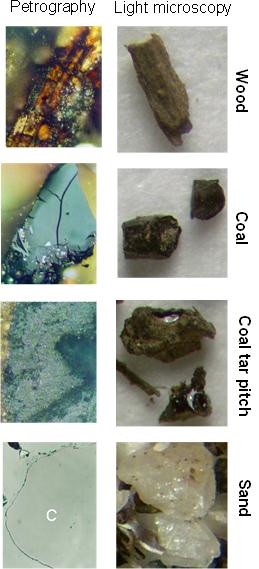
Light microscopy and petrography images of the four most abundant
and relevant particle types present in Manufactured Gas Plant site
sediments.
|
The Determination of Sediment Polycyclic Aromatic
Hydrocarbon (PAH) Bioavailability using Supercritical Fluid Extraction
(SFE) and Ultra-Trace Porewater (UTP) analysis.
D. Nakles, A. Hawkins,
S. Hawthorne, T. S. Bridges, U. Ghosh.
Duration: 2008-2010
Funding agency: Environmental Security Technology Certification
Program (DoD)
Summary. Studies of the bioavailability and toxicity of PAHs
in sediments have shown that the use of total PAH concentrations to
predict aqueous concentrations in porewater often overestimates the
risk to aquatic organisms. The observed lack of toxicity at high sediment
PAH concentrations has been attributed to the fact that these compounds
are much more strongly bound to sediment organic carbon than is assumed
by the standard equilibrium partitioning model. Mild supercritical
fluid extraction (SFE) using carbon dioxide has been shown to be a
good estimator of PAH bioavailability to benthic macro invertebrates
in freshwater sediments, and ultra-trace porewater (UTP) analysis using
solid phase microextraction (SPME) has been used to accurately measure
the dissolved concentration of PAHs in sediment porewater. Both of
these methods have been demonstrated to successfully predict the toxicity
of freshwater sediments with much greater accuracy than is achieved
by the use of generic sediment screening guidelines based on total
PAH concentrations.
The proposed demonstration/validation project is designed to build
upon the data developed to date demonstrating how site-specific estimates
of PAH bioavailability in freshwater sediments can be used to predict
toxicity to benthic freshwater species. The goal of the proposed project
is to extend the application of SFE and UTP estimates of PAH bioavailability
to marine/estuarine sediments and species. Specifically, the project
objectives are to 1) use SFE and UTP analyses to predict the bioavailability
of PAHs in marine/estuarine sediments collected from two Navy facilities,
2) show the relationship between predictions of PAH bioavailability
and the actual measured toxicity to a marine/estuarine macro invertebrate
species and 3) demonstrate the application and develop technical guidance
on the use of SFE and UTP as site-specific measurements of PAH bioavailability
for assessing risk.
|